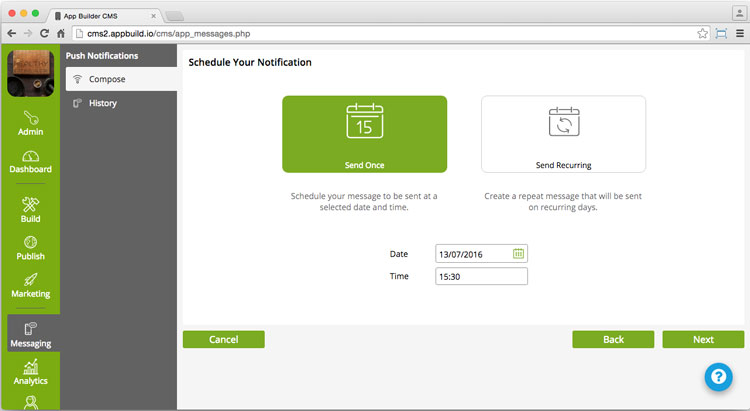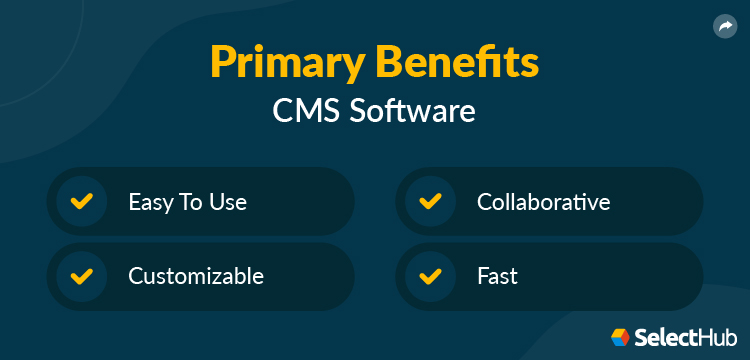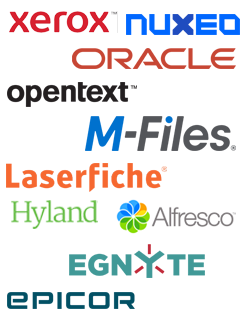Before content management systems, you needed to know HTML if you wanted to create a website. Now, thanks to CMS, anyone can create and publish web content even without knowing how to code.
If you’re in the market for a CMS, you know how many options are out there. That’s why we’re breaking down the top 10 most valuable CMS features no business can do without. Let’s dive in!
Get our CMS Software Requirements Template

Article Roadmap
What Is a Content Management System?
A content management system is a tool that empowers users to generate, edit, handle, organize, publish and share content on a website without requiring advanced technical knowledge. The software contains a programming framework, a database and a presentation layer. Content editors deal with the presentation layer, undertaking all content-related tasks without having to code.
A CMS makes content publishing easy — in fact, as of November 2022, more than 80 million websites have been created using a CMS. Any business size and type can use it, though its most common applications are blogs and web pages.
Most CMS systems have two main parts:
- Content management application (CMA), where content creators work on and manage the content without the need for IT assistance.
- Content delivery application (CDA), the back-end part of the website that takes the content users enter into templates and makes it into a working website.
Common content management systems include WordPress, Drupal and Joomla.
Compare Top CMS Software Leaders
Key Features
Though the features your business needs might be different from what works for another business, most businesses benefit from core content management system features. Here’s our go-to list of CMS features to get you started.
1. AI-Based Capabilities
Artificial Intelligence is used in content management systems for analysis and content processing, streamlining content management and organization.
AI-powered image recognition and tagging tools analyze images instantly. This is especially useful for search engine optimization and eCommerce sites or image sites that have thousands of new pictures uploaded daily. AI tools make sure the right images are matched up with appropriate keywords.

Automatically identifying the most valuable information. Source
If you’re dealing with high volumes of content, AI-based content capture makes extracting information from various sources effortless. Other AI-based functionalities include intelligent indexing, content search, content classification and personalized recommendations.
2. Collaboration
CMS platforms improve collaboration with capabilities like document co-authoring and multi-workspace. They also support multiple communication channels, including email and text.
Multi-workspace support enables employees across different departments of an organization to collaborate on different tasks and projects, working individually or in teams.
Document co-authoring enables multiple staff members to work simultaneously on one file. Employees can add, edit and delete content in real time, and see other users’ work with instant version updates. The unified content repository makes files accessible to employees across departments, working from any location, at any time.
3. Compliance
Most CMS platforms have data security measures to protect your company’s information and to maintain compliance with privacy standards like GDPR, CCPA and PII or record management standards like WORM and SAHKE2. You might also consider options like WebDAV, ISO/IEC and FIPS 140-3.
Whether it belongs to your company or your clientele, measures like these ensure that all sensitive information in your CMS is safe.
4. Content Capture
Intelligent content capturing extracts, processes, organizes and stores information. It can work through batch scanning, bulk import, custom webforms, barcode recognition and optical character recognition. Let’s go over each type in detail.
Batch Scanning
Batch scanning helps companies work through high volumes of content, using a document scanner for high-volume hardcopy scanning.

Collecting index information from different pages and filing it into a folder. Source
Bulk Import
Users can use mass or bulk document importing from a specific database or content repository. This way, you don’t have to waste time uploading files one by one.
Custom Webforms
With custom webforms, you can collect information from websites according to dynamic field rules you set. You can use them for a variety of reasons, but tracking customer and lead information are some of the most common uses.
Barcode Recognition
This quick identification tool is used mostly in retail stores and warehouses as part of the payment process and to track and manage inventory. Barcode, or QR code, recognition ensures accurate billing and indexing that expedites the search for items in your repository.
Optical Character Recognition (OCR)
Also known as text recognition, OCR automatically extracts data from scanned files and images. It converts printed documents into text that machines can read and organize.
5. Document Management
The feature enables businesses to upload, track, index, organize and store electronic versions of paper-based files. It’s most helpful for companies that deal with large volumes of sensitive or confidential documents.
You can use the document search function to browse the company’s database using metadata like name, date and file author. The drag-and-drop feature easily moves files from one place to another, allowing employees to drag and drop documents or folders from their desktops into the content repository.

Granting dynamic permissions to users. Source
Role-based permissions can enable or restrict access to certain documents. You can choose which employees can edit, delete or share information based on privacy and need. Version control allows employees to collaborate in real time, reducing the possibility of redundant work.
Get our CMS Software Requirements Template
6. Document Protection
In addition to keeping files safe, it’s also important to ensure your information is up to date. Features like content archiving, duplicate detection, lock documents and watermarks keep your content secure and accurate.
Content archiving enables your company to maintain extensive records that may be useful in case a legal issue arises. Users can also use built-in analytics tools to evaluate content performance based on your archives. The CMS can automatically detect and eliminate any duplicate files, saving space.
Like role-based permissions, lock documents keep documents “locked” until they’re made accessible again, or make them accessible to only a select group of users. Once your content is ready to publish, watermarks help safeguard it from plagiarism and copyright issues, especially if you’re putting out visual media.
7. Mobile Capabilities
Mobile content management systems are generally faster to set up and use than traditional ones. With over 15 billion mobile devices operating worldwide, it’s ideal for CMS platforms to be mobile-focused or provide mobile capabilities as an additional feature for users.

Composing and scheduling customized notifications. Source
A mobile CMS allows users to edit, share and publish content using a smartphone or mobile device from anywhere in the world. Frontend users can access the interface on their mobile phones, making engagement more accessible and eliminating the hassle of loading a version that’s not mobile-optimized.
You can also send push notifications, alerts, personalized messages and more to users. Most key features, like fillable forms and documents capture, work just as well on mobile devices as they do on desktop. And most solutions allow employees to update files and submit forms even without internet connection in offline mode.
8. Platform Capabilities
Let’s go over some of the essential CMS platform capabilities in detail.
Audit Trail
The functionality allows you to track all changes made to documents across the knowledge system. Admins can access information, including which employees were active on which file, the date and time of the file created, and what edits were made to the content.
Role-Based Permissions
This allows admins to assign specific permissions to employees based on their role in their company or according to their department. For instance, an editor has permission to add, edit or delete content. Some employees can be granted permission to view content without being able to modify it.
Single Sign-On (SSO)
Single sign-on is a helpful feature that lets organizations with multiple devices to use a single set of credentials (usually username and password) to log in. It can be used by multiple employees, saving time and increasing access.
Multi-Language Support
This feature enables your system to support various languages and change the language option on the user interface whenever required.
Rebranding
You can brand the platform using visual aspects, like different colors and themes, that fit well with your business’s identity. For further customization, you can add a logo and URL of your company name.
Two-Factor Authentication
For enhanced data privacy, employees can secure their accounts through two-factor authentication methods like security questions, one-time passwords or security tokens. This additional layer of security helps keep your data even safer.
Get our CMS Software Requirements Template
9. Reports and Analytics
With reporting and analytics tools, you can gain detailed insights into your customers’ behavior and demographics, including information like their location, the devices they use and how they engage with your content. You can also see how well your content is performing, and use that information to adjust your content strategy.

Analyze multiple metrics on the dashboard. Source
Most CMS have in-built analytics for measuring different key performance indicators or KPIs. In addition to reports, visualizations like graphs and pie charts help make it easier to understand your data and use it effectively.
10. Integrations and Extensibility
Integrations and extensibility matter because they expand on the core capabilities of your CMS, and make your new platform compatible with other programs your business already uses.
Some plugins and modules make your CMS more customizable, while others, like social media integrations or marketing tools, can even help increase your web traffic and expand your reach.
Specific integrations to look out for are CRM, eCommerce, marketing technology and social media.
Primary Benefits of a CMS
A CMS has numerous perks to offer for your business. Let’s take a look at them.

Easy To Use
You don’t need technical expertise to operate most content management systems. They’re easy to use and navigate, reducing how much you depend on your IT team. Any user in the company can upload images, text, videos and content without having any development experience.
Customizable
CMS provides various customization options via themes, designs and layouts. Users can also employ plugins and extensions to build on the base theme. And if you want to get more technical, the option to edit the source code directly is usually available.
Collaborative
Whether your employees are in office or working from home, a CMS allows them to easily collaborate on all aspects of the content creation and publication processes. The solution is also scalable, providing tools that help you stay afloat as content demands increase.
Fast
To stay relevant and competitive, your web content needs a regular refresher. A CMS allows you to update content instantly, so the changes you make appear live on the site as soon as you preview and approve them.
Next Steps
Finding the right CMS for your company might seem daunting, especially with all the competitive options on the market. Having a list of the key CMS features you need is a great starting point for your software selection process.
Need a little more help? Try our free requirements template to customize your must-have features and more easily find products that match your needs.
So, which CMS features will you look for? Are there any important ones we missed? Let us know in the comments below!

Leave a Reply